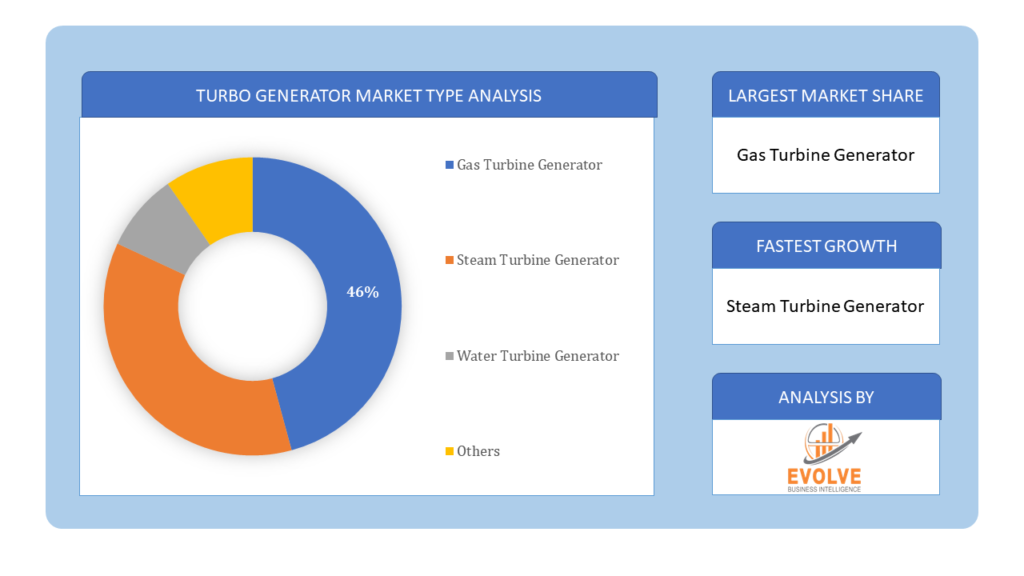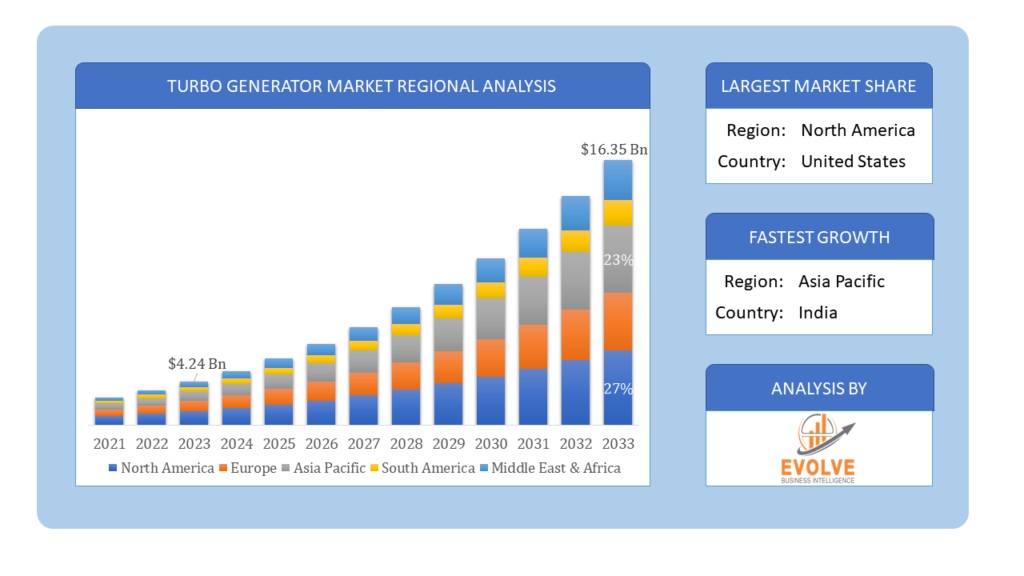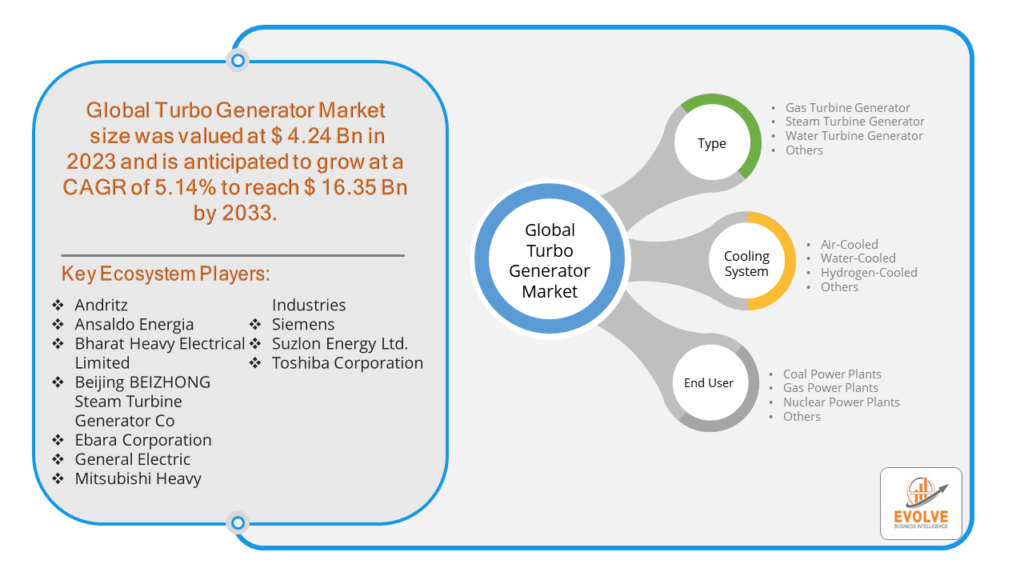Price range: $ 1,390.00 through $ 5,520.00
Turbo Generator Market Research Report: Information By Type (Gas Turbine Generator, Steam Turbine Generator, Water Turbine Generator, Others), By Cooling System (Air-Cooled, Water-Cooled, Hydrogen-Cooled, Others), By End-User (Coal Power Plants, Gas Power Plants, Nuclear Power Plants, Others), and by Region — Forecast till 2033
Page: 151
Description
Turbo Generator Market Overview
The Turbo Generator Market Size is expected to reach USD 16.35 Billion by 2033. The Turbo Generator Market industry size accounted for USD 4.24 Billion in 2023 and is expected to expand at a compound annual growth rate (CAGR) of 5.14% from 2023 to 2033. The Turbo Generator Market refers to the global industry involved in the manufacturing, sales, and distribution of turbo generators. Turbo generators are mechanical devices that convert mechanical energy into electrical energy using a turbine-driven generator. They are commonly used in power plants and other industrial applications to produce electricity.
The market is influenced by factors such as energy policies, technological advancements, and economic growth, which drive the demand for efficient and reliable power generation solutions. The market is expected to grow, due to factors such as increasing urbanization, rising demand for electricity in developing countries, and the growing need for cleaner sources of energy.
Global Turbo Generator Market Synopsis
The COVID-19 pandemic had a significant impact on the Turbo Generator Market. Lockdowns and restrictions led to temporary shutdowns of manufacturing facilities, causing delays in production and delivery schedules. Shortages of raw materials and components due to disrupted global supply chains affected manufacturing processes. Transportation restrictions and reduced workforce availability led to delays in shipping and installation of turbo generators. Many power generation projects were postponed or cancelled due to economic uncertainties and budget constraints. The pandemic accelerated the shift towards renewable energy sources as governments and companies focused on sustainable recovery plans. Investment in renewable energy projects, such as wind and solar, may lead to changes in the demand for traditional steam and gas turbo generators. The market is likely to see increased focus on innovative technologies and solutions to enhance efficiency and reduce emissions.
Turbo Generator Market Dynamics
The major factors that have impacted the growth of Turbo Generator Market are as follows:
Drivers:
Ø Technological Advancements
Innovations in turbine and generator technologies enhance the efficiency and reliability of turbo generators, making them more attractive to power producers. The development of new materials and designs improves the performance and lifespan of turbo generators. The continuous rise in global energy consumption, driven by population growth and industrialization, increases the demand for efficient power generation solutions like turbo generators. Rapid urbanization in developing countries leads to increased electricity requirements for residential, commercial, and industrial applications. Turbo generators are valued for their ability to provide a stable and continuous power supply, making them essential for critical applications such as hospitals, data centers, and industrial facilities.
Restraint:
- Perception of High Initial Costs and Fluctuating Fuel Prices
The installation of turbo generators requires significant upfront capital investment, which can be a barrier for many organizations and power producers, particularly in developing regions. Implementing the latest technologies and materials to improve efficiency and reduce emissions can further increase costs. The market is sensitive to fluctuations in the prices of fuels like natural gas and coal, which can affect the operating costs and competitiveness of turbo generators. Unpredictable fuel prices can impact the profitability of power generation projects using turbo generators.
Opportunity:
⮚ Growing Demand for Clean Energy
Turbo generators can be integrated with renewable energy systems such as biomass and waste-to-energy plants, offering opportunities for growth in the clean energy sector. Developing hybrid systems that combine conventional and renewable power generation can enhance efficiency and reliability, creating new market opportunities. The growing adoption of CHP systems, which utilize waste heat for additional energy production, presents opportunities for turbo generators in industrial and commercial applications. CHP systems offer significant cost savings and efficiency improvements, making them attractive to a wide range of industries.
Turbo Generator Market Segment Overview
By Type
 Based on Type, the market is segmented based on Gas Turbine Generator, Steam Turbine Generator, Water Turbine Generator and Others. The gas turbine generator segment dominant the market. The need for turbo generators is anticipated to develop due to increased demand for gas turbine generators for electricity generation from various industries, including oil and gas, power, big industry, and others over the forecast period. Additionally, manufacturers are paying more attention to research and development for gas turbine generators due to growing environmental concerns, which will fuel market expansion in the future.
Based on Type, the market is segmented based on Gas Turbine Generator, Steam Turbine Generator, Water Turbine Generator and Others. The gas turbine generator segment dominant the market. The need for turbo generators is anticipated to develop due to increased demand for gas turbine generators for electricity generation from various industries, including oil and gas, power, big industry, and others over the forecast period. Additionally, manufacturers are paying more attention to research and development for gas turbine generators due to growing environmental concerns, which will fuel market expansion in the future.
By Cooling System
Based on Cooling System, the market segment has been divided into Air-Cooled, Water-Cooled, Hydrogen-Cooled and Others. The air-cooled segment dominant the market. Turbine generators that are used continuously cause various parts to heat up. Therefore, air-cooled systems are more necessary due to the need for cooling systems to lessen or remove heat generated within them. As the name implies, air-cooled turbo generators use forced or ambient air to keep the generators from overheating. The air intake system is the sole additional component in the generating system used by an air-cooled turbo generator. These systems might be fully enclosed or open to the air.
By End User
Based on End User, the market segment has been divided into Coal Power Plants, Gas Power Plants, Nuclear Power Plants and Others. The coal power plants segment dominant the market. Steam turbo generators are used in coal-based power plants to generate electricity. The International Energy Agency (IEA) estimates that coal accounts for more than 40% of carbon dioxide emissions and nearly 35% of energy generation. An increase in energy demand from both developing and developed economies is anticipated to fuel the expansion of coal-based power production, which will fuel the growth of the turbo generator market.
Global Turbo Generator Market Regional Analysis
Based on region, the global Turbo Generator Market has been divided into North America, Europe, Asia-Pacific, the Middle East & Africa, and Latin America. North America is projected to dominate the use of the Turbo Generator Market followed by the Asia-Pacific and Europe regions.
 Turbo Generator North America Market
Turbo Generator North America Market
North America holds a dominant position in the Turbo Generator Market. North America has a mature turbo generator market, with significant installations in power plants and industrial facilities. The region is characterized by a focus on modernization and upgrading existing power infrastructure. Emphasis on reducing carbon emissions and increasing energy efficiency drives the adoption of advanced turbo generators and growing investments in renewable energy projects, such as biomass and waste-to-energy, create opportunities for turbo generators.
Turbo Generator Asia-Pacific Market
The Asia-Pacific region has indeed emerged as the fastest-growing market for the Turbo Generator Market industry. Asia-Pacific is the fastest-growing region in the turbo generator market, driven by rapid industrialization, urbanization, and population growth. The region has a diverse energy mix, with a strong presence of coal, gas, and emerging renewable energy sources. Expanding energy infrastructure and increasing electricity demand create significant opportunities for turbo generator deployment and economic uncertainties and fluctuations in fuel prices can affect market stability.
Competitive Landscape
The global Turbo Generator Market is highly competitive, with numerous players offering a wide range of software solutions. The competitive landscape is characterized by the presence of established companies, as well as emerging startups and niche players. To increase their market position and attract a wide consumer base, the businesses are employing various strategies, such as product launches, and strategic alliances.
Prominent Players:
- Andritz
- Ansaldo Energia
- Bharat Heavy Electrical Limited
- Beijing BEIZHONG Steam Turbine Generator Co
- Ebara Corporation
- General Electric
- Mitsubishi Heavy Industries
- Siemens
- Suzlon Energy Ltd.
- Toshiba Corporation
Key Development
In February 2021, The O&M service agreement for Hummel Station was given to PIC Group by LS Power Group Inc.. This will guarantee consistency and dependability in operations to reach extreme financial and operational objectives.
In October 2022, Rolls Royce declared that it will offer all MTU generator sets that power the British Royal Navy fleet long-term service support. For the following five years, the business agreed to a contract for the preemptive maintenance of 90 MTU engines.
Scope of the Report
Global Turbo Generator Market, by Type
- Gas Turbine Generator
- Steam Turbine Generator
- Water Turbine Generator
- Others
Global Turbo Generator Market, by Cooling System
- Air-Cooled
- Water-Cooled
- Hydrogen-Cooled
- Others
Global Turbo Generator Market, by End User
- Coal Power Plants
- Gas Power Plants
- Nuclear Power Plants
- Others
Global Turbo Generator Market, by Region
- North America
- US
- Canada
- Mexico
- Europe
- UK
- Germany
- France
- Italy
- Spain
- Benelux
- Nordic
- Rest of Europe
- Asia Pacific
- China
- Japan
- South Korea
- Indonesia
- Austalia
- Malaysia
- India
- Rest of Asia Pacific
- South America
- Brazil
- Argentina
- Rest of South America
- Middle East & Africa
- Saudi Arabia
- UAE
- Egypt
- South Africa
- Rest of Middle East & Africa
| Parameters | Indicators |
|---|---|
| Market Size | 2033: $16.35 Billion |
| CAGR | 5.14% CAGR (2023-2033) |
| Base year | 2022 |
| Forecast Period | 2023-2033 |
| Historical Data | 2021 |
| Report Coverage | Revenue Forecast, Competitive Landscape, Growth Factors, and Trends |
| Key Segmentations | Type, Cooling System, End User |
| Geographies Covered | North America, Europe, Asia-Pacific, Latin America, Middle East, Africa |
| Key Vendors | Andritz, Ansaldo Energia, Bharat Heavy Electrical Limited, Beijing BEIZHONG Steam Turbine Generator Co, Ebara Corporation, General Electric, Mitsubishi Heavy Industries, Siemens, Suzlon Energy Ltd. And Toshiba Corporation |
| Key Market Opportunities | • Growing Demand for Clean Energy • Focus on Combined Heat and Power (CHP) Systems |
| Key Market Drivers | • Technological Advancements • Increasing Electricity Demand |
REPORT CONTENT BRIEF:
- High-level analysis of the current and future Turbo Generator Market trends and opportunities
- Detailed analysis of current market drivers, restraining factors, and opportunities in the future
- Turbo Generator Market historical market size for the year 2021, and forecast from 2023 to 2033
- Turbo Generator Market share analysis at each product level
- Competitor analysis with detailed insight into its product segment, Government & Defense strength, and strategies adopted.
- Identifies key strategies adopted including product launches and developments, mergers and acquisitions, joint ventures, collaborations, and partnerships as well as funding taken and investment done, among others.
- To identify and understand the various factors involved in the global Turbo Generator Market affected by the pandemic
- To provide a detailed insight into the major companies operating in the market. The profiling will include the Government & Defense health of the company’s past 2-3 years with segmental and regional revenue breakup, product offering, recent developments, SWOT analysis, and key strategies.
Frequently Asked Questions (FAQ)
2.What is the growth rate of the global Turbo Generator Market?
- The global Turbo Generator Market is growing at a CAGR of 5.14% over the next 10 years
3.Which region has the highest growth rate in the market of Turbo Generator Market?
- Asia Pacific is expected to register the highest CAGR during 2023-2033
4.Which region has the largest share of the global Turbo Generator Market?
- North America holds the largest share in 2022
5.Who are the key players in the global Turbo Generator Market?
Andritz, Ansaldo Energia, Bharat Heavy Electrical Limited, Beijing BEIZHONG Steam Turbine Generator Co, Ebara Corporation, General Electric, Mitsubishi Heavy Industries, Siemens, Suzlon Energy Ltd. And Toshiba Corporation are the major companies operating in the market
6.Do you offer Post Sale Support?
- Yes, we offer 16 hours of analyst support to solve the queries
7.Do you sell particular sections of a report?
Yes, we provide regional as well as country-level reports. Other than this we also provide a sectional report. Please get in contact with our sales representatives
Additional information
| Packages | Single User License, Enterprise License, Data Pack Excel |
|---|
Table of Content
[html_block id="7610"]

